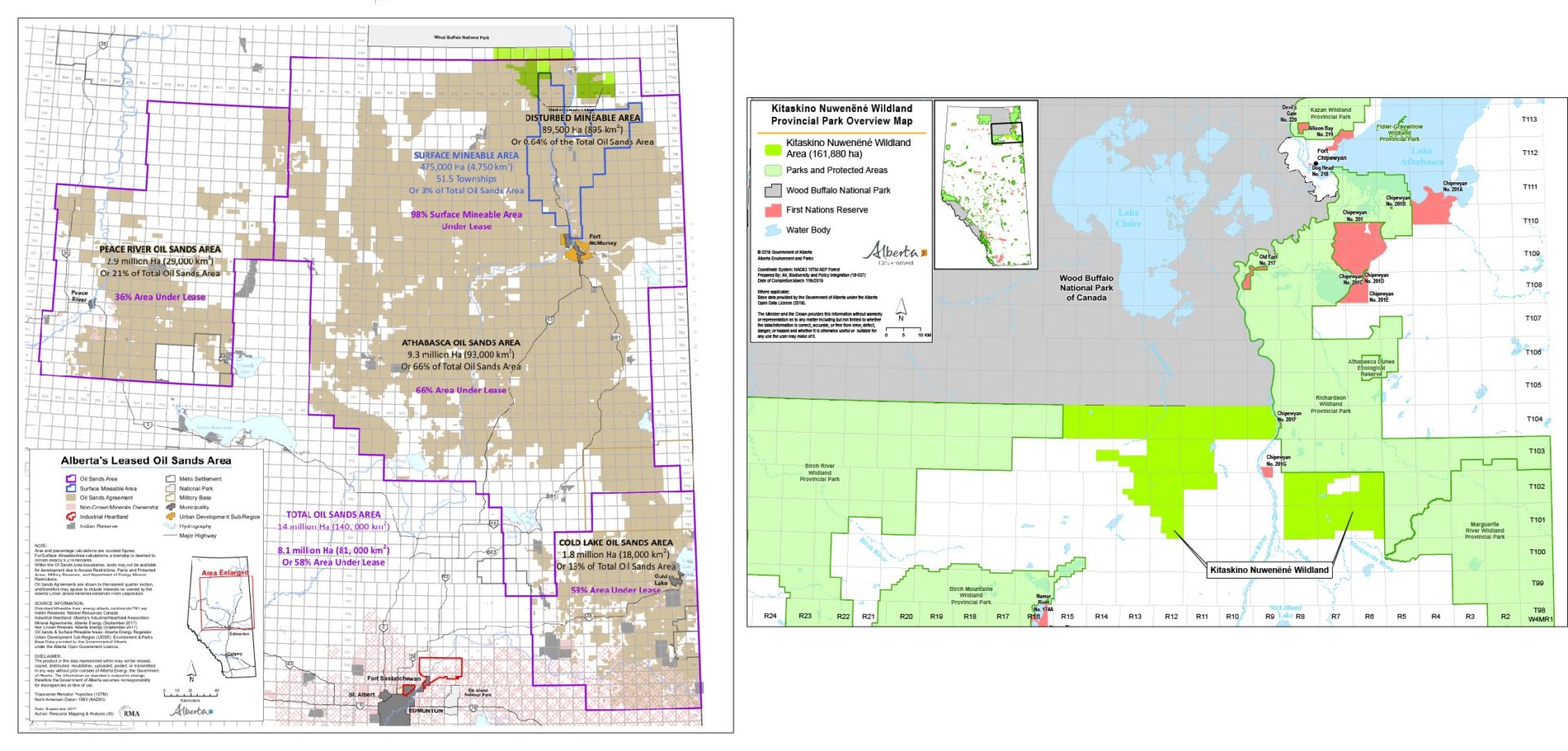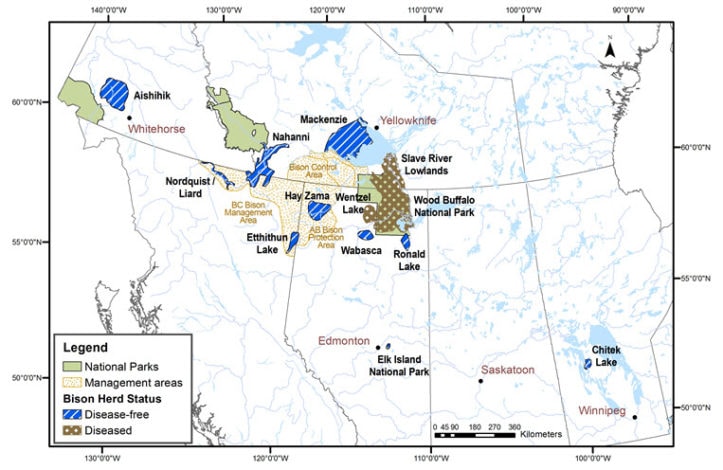
Meet Manuel Baechlin, The Narwhal’s video producer
We’ve long been told our award-winning visual journalism should include videos that make the conversation...
Four years ago the Mikisew Cree First Nation proposed the creation of a buffer zone around Wood Buffalo National Park to preserve land for traditional activities as oilsands projects surrounding Fort McMurray crept further north.
That buffer zone is now the 161,880-hectare Kitaskino Nuwenene Provincial Park — Alberta’s newest wildland park, designed to remain open to traditional land use by Indigenous peoples.
Flanked by Wood Buffalo, a UNESCO World Heritage Site, to the north and Teck Resources’ proposed Frontier mine to the south, Kitaskino is being applauded as an example of the benefits of Indigenous communities, government and the oil and gas industry working together.
Yet Mikisew Cree leaders are warning that almost double the amount of land needs to be protected from industrial development to form an effective buffer to the beleaguered national park,
which is at imminent risk of being designated as a World Heritage Site in Danger.
On its website Alberta Parks said the park “will safeguard Indigenous peoples’ way of life while addressing concerns raised in a 2016 UNESCO report on Wood Buffalo National Park.”

Left: Government of Alberta map showing leased oilsands areas. The new Kitaskino Nuwenëné Wildland Provincial Park can be seen added in green. Right: Government of Alberta map detailing the Kitaskino Nuwenëné Wildland areas.
Water levels in Wood Buffalo and the Peace-Athabasca delta have fallen since construction of the WAC Bennett Dam on the Peace River and there are growing fears that problems will be exacerbated by construction of the Site C dam.
The dropping water levels and lack of ice jams, combined with climate change and water withdrawals by the oil and gas industry, mean Indigenous communities can no longer trap in traditional areas and parts of the delta are silting up.
The deteriorating conditions sparked a request by Mikisew Cree for a monitoring mission by the UNESCO World Heritage Centre and International Union for Conservation of Nature, a visit which led to UNESCO considering adding Wood Buffalo to the list of World Heritage in Danger.
One of 17 UNESCO recommendations for improving the condition of the park is for a buffer zone around Wood Buffalo. Kitaskino Nuwenene adds to two previously announced parks on the edge of Wood Buffalo, which may help Canada’s case when it presents it action plan to the World Heritage Committee at its July meeting in Azerbaijan.
However, the action plan does not act on the key UNESCO recommendation to conduct an assessment of the effects of the Site C dam as the federal government says it does not have the authority to start a new study of the already-approved project.
Alberta Environment and Parks spokesman Scott Lundy said the Kitaskino Nuwenene wildland will protect watersheds from future development, contribute to a Wood Buffalo conservation buffer and help protect woodland caribou and the Ronald Lake bison herd, one of only three free-ranging, disease-free bison herds in Alberta.
“The park represents a significant portion of the range of the herd,” he said.
The new park was created after three companies — Teck Resources, Cenovus Energy and Imperial Oil — voluntarily gave up oilsands and mining leases in the area following negotiations with the Alberta government and Indigenous groups.
The park will be closed to forestry and new energy projects, but existing wells will keep operating.
Alberta Parks will work with Indigenous groups to cooperatively manage the area.
Among the supporters of the new park project are the Athabasca Chipewyan Cree First Nation, Fort McKay First Nation, Fort Chipewyan Metis, Fort McKay Metis, Fort McMurray Metis and the Athabasca Tribal Council.
Teck, Cenovus and Imperial gave up their leases without financial compensation and Mikisew Cree obtained federal funding to buy out leases held by Value Creation Group of Companies.
Columba Yeung, Value Creation CEO, said in an emailed response to questions from The Narwhal that the company supports Mikisew’s biodiversity program, but does not have the financial flexibility of the big players.
“We are still a company with big aspirations, but (as yet) modest financial means,” he said.
Teck spokesman Chris Stannell said the company recognizes the significant cultural and ecological importance of the boreal forest and Wood Buffalo National Park and has been working for several years with Mikisew, Athabasca Chipewyan First Nation and other Indigenous groups to create the new conservation area.
“Teck is proud to be part of the establishment of this important conservation initiative and to be able to directly contribute our leases to the establishment of the wildland park,” he said.
However, more land must be added if the buffer is to be effective, said Melody Lepine, Mikisew Cree industry relations director.
“We are slowly making our way to having a full buffer. This new park is a portion of that, but we have a lot of work to do to add a larger buffer area. This is just a piece of that puzzle,” said Lepine, who believes the willingness of government and industry to make a deal indicates that everyone is starting to recognize the importance of Wood Buffalo.
About another 150,000 hectares, including leases held by Canadian Natural Resources Ltd. to the west of the Athabasca River, are needed for the buffer to be effective, she said.
“We are pleased to have phase one completed, but by no means does this mean we are done. We need to work on phase two to create that full buffer to ensure there’s going to be no development just south of Wood Buffalo National Park,” she said.
If the Peace-Athabasca delta is to be protected it’s essential that tributaries that run into rivers supplying water to the delta should not be mined, Lepine said.
Also, land that is not yet in the buffer zone is the heart of critical habitat for the Ronald Lake bison herd, she said.
“We need that for strong protection of that herd,” she said.
Talks on phase two have already started, according to Lepine, but an Alberta government spokesman said “there are currently no negotiations underway for expanding the protected area.”
CNRL did not provide comment to The Narwhal.
Lepine, who will be attending the World Heritage Committee meeting in Azerbaijan, believes a commitment to a full buffer zone will help Canada’s case.
“We need more of this sort of action. We need to see deliverables, we need to see results,” Lepine said.
“This was an initiative that was spearheaded by Mikisew, but we need to see more from the provincial and federal governments. There is so much more that needs to be done,” she said.

Locations of free-ranging wood bison herds in Canada. Map: Species At Risk public registry
Creation of the park is a recognition of Indigenous commitment to protecting land rights, Mikisew Cree Chief Archie Waquan said in a statement.
“We appreciate the collaborative efforts by industry and the provincial and federal governments to make this park a reality,” he said.
But, Waquan is also pushing for increased protection.
“Now is the time to build on this momentum and protect the rest of the habitat of the Ronald Lake bison herd, more watersheds that flow into Wood Buffalo National Park and other areas that support the Peace Athabasca delta and our treaty rights,” he said.
Get the inside scoop on The Narwhal’s environment and climate reporting by signing up for our free newsletter. On March 17, federal Conservative Leader Pierre Poilievre...
Continue reading
We’ve long been told our award-winning visual journalism should include videos that make the conversation...

We’re launching The Narwhal’s video work in 2025 with a deep dive into a tax...

Energy Minister Adrian Dix is touting electrifying industries like mining and LNG as key to...
